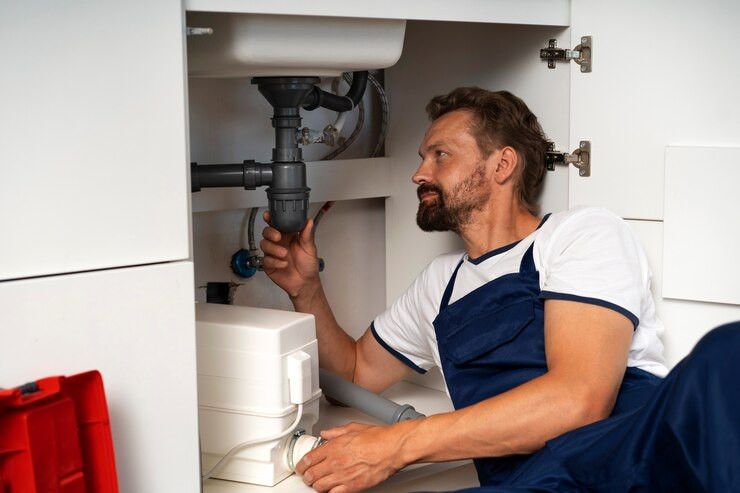How to Plan a Whole-House Plumbing Repipe
Posted on September 04, 2024 by Admin

This is going to be an extended work that will require some planning and organization. Repiping your whole house's plumbing system is the key to a more dependable and efficient water supply at home. Your pipes can just be too old, corroded, or even annoying with continuous leakage. This paper thus takes you through the planning of your whole-house repiping for smoothness and success, outlining principal steps and considerations.
1. Checking if You Need a Plumbing Repipe
The first thing in your plan for the whole-house plumbing repipe is to assess if it really is needed. Some of the signs that may tell you that it's time to repipe the house include frequent leaks, low pressure, rust or discolored water, and old pipes made from galvanized steel or polybutylene. If most of these, if not all, apply to your situation, that shall be the right point at which you should repipe to avoid further damage and thus save on costly repairs.
2. Establish Budget
A plumbing repipe is, potentially, a large investment; having a realistic budget in place is paramount. Clearly, the costs will vary on the size of your house, type of piping material used, and local labor rates. Be sure to get a few estimates from licensed plumbers to have an idea of the price range and be sure you have enough money to complete the project with contingencies that may pop up.
3. Selecting the Appropriate Piping Material
Select appropriate piping material for your plumbing repipe. This would be copper, PEX, and CPVC. Chlorinated polyvinyl chloride and cross-linked polyethylene have the following pros and cons:
Copper
It is the most long-lasting and durable of all; it is also the priciest. Still, it is susceptible to some forms of corrosion.
PEX
It's more supple and resistant to scaling and chlorine; in addition, it is easier to install.
CPVC
While probably inexpensive with high corrosion resistance, it embrittles easily.Consult your plumber about what best works for you at home, considering specific needs and conditions.
4. Making Sure You Hire a Qualified Plumbing Contractor
You get the quality of plumbing repipe that you have in the contractor you hire. Be sure to seek licensed, insured, well-reviewed professionals known for doing a repipe the right way. Verify their credentials. Request references to make sure they are suitable for your project, and find out whether they can complete the work according to your schedule.

5. Plan Out the Project Timeline
Depending on the size of your house and how complex the work is, whole-home repiping may take several days or several weeks. Give the process a realistic timeline that won't impact your everyday activities; work with your plumber. Consider all factors relevant in your situation: family schedules, material availability, weather, or other elements that may affect the project.
6. Prepare Your Home
Of course, before plumbing repipe actually commences, you would have to prepare your home for the task. This may include access pipe clearing, protection of furniture or other personal stuff, and some temporary arrangement for water supply, if needed. Further details on what one should do to get the house ready for repiping will be provided by the plumbing contractor.
7. Be Informed About the Process
Understanding the steps involved in a repipe project is essential.
It will more than likely be made up of the following sequential steps:
1. Assessment and Plans
Detailed investigation into pipework layout before repiping.
2. Shut Off Water Supply
Closure of the main house water supply.
3. Old Pipes Removal
Safety isolation of old pipes and preliminary works carried out in the installation locations.
4. Laying New Pipes
Lay new pipes throughout the house, ensuring that all the connections and fittings are perfectly done.
5. Testing and Inspection
All tests for leaks or other issues within the new plumbing system, and to make sure everything is working correctly.
6. Restoration
Any opened walls and/or floors as a result of the process are repaired.
8. Post-Installation Considerations
Now that your plumbing repipe is complete, here are some things to consider regarding what to expect after installation. Be sure that your plumber goes through the new system in detail with you and answers all of your questions. Save all documents regarding work done, warranties, and maintenance instructions. A new plumbing system, like any other complex system, will require regular maintenance and inspection to ensure years of great service.
Also Read :
How to Identify and Repair Hidden Water Leaks
The Benefits of Regular Drain Cleaning Services
How to Plan a Bathroom Remodel with Plumbing in Mind
Faqs
-
1. What is a plumbing repipe, and why does my home need it?
A plumbing repipe is a replacement of all the pipes in your home's plumbing system. Homes may need a plumbing repipe due to frequent leaks, low water pressure, or old, corroded pipes made from outdated materials like galvanized steel or polybutylene.
-
2. How long does a whole-house plumbing repipe take?
The length of time a plumbing repipe takes is determined mainly by the size of your house and the system's complexity. Generally, it will run from a few days to a couple of weeks.
-
3. What kinds of piping materials are best for a plumbing repipe?
Common materials used in plumbing pipes include copper, PEX. Each one has its good and not-so-good points, so you're better off discussing this with your plumber to pick out the right one for your needs
-
4. How much does it cost for a repipe?
The cost of any plumbing repipe can vary tremendously depending on the size of the house, type of piping material used, and labor rates in your area. Obtaining multiple estimates from licensed plumbing contractors will give you a better idea of what to expect.
Recent Post
- Top Plumbing Service Providers in Arizona, USA
- Top 10 Electrician Service Providers in Alabama, USA
- Top 20 Roof Repair Service Providers in Alabama, USA
- The Role of Roof Insulation in Energy Efficiency: Tips and Tricks
- Understanding Roof Damage from Wildlife and How to Prevent It
- How to Choose the Best Roofing Contractor for Emergency Repairs
- Roofing Maintenance for Historic Homes: Preserving Architectural Integrity
- The Importance of Proper Attic Ventilation for Roof Health
- How to Identify and Prevent Roof Mold and Mildew
- The Best Practices for Removing Snow from Your Roof